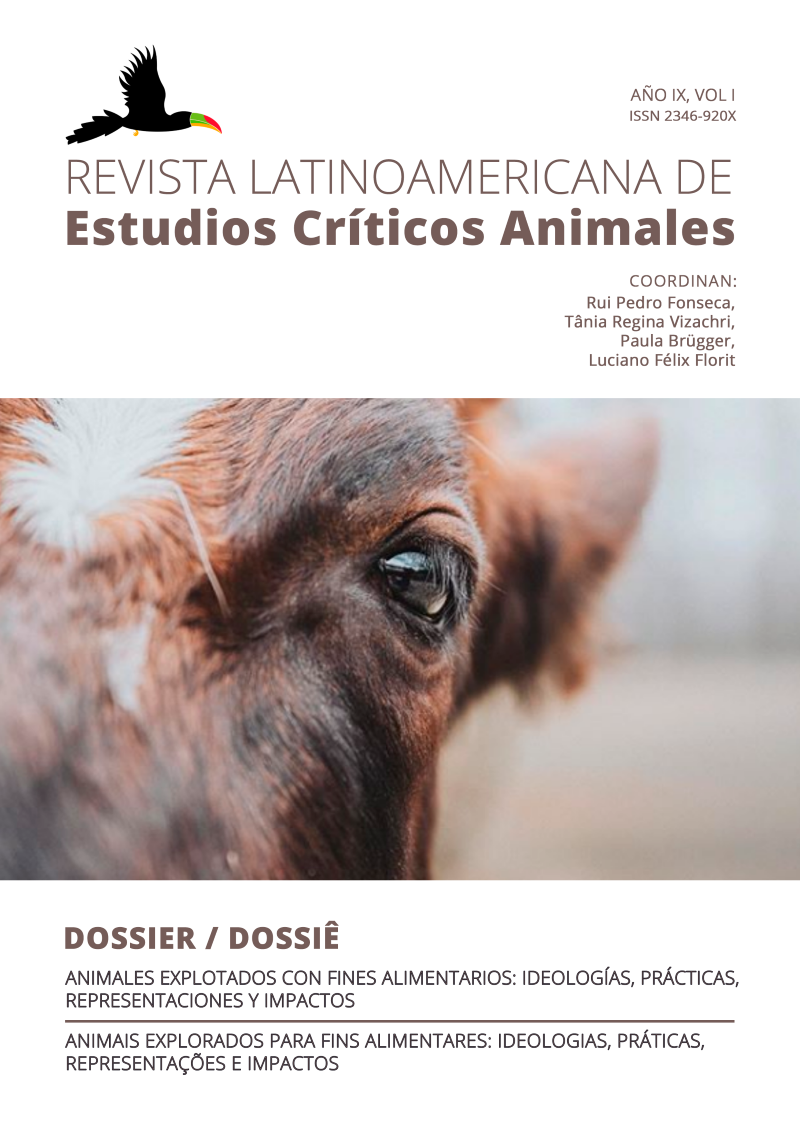AQUATIC ANIMALS: THE FORGOTTEN VICTIMS OF SPECIESISM. ETHICAL PROBLEMS AROUND FISHING
Keywords:
fish farming, fishing, animal ethics, aquatic animalsAbstract
While there is increasing moral consideration for some non-human animals (mammals and birds), little consideration is given to aquatic animals (fish, cephalopods, and crustaceans). They are often forgotten by the animal movement itself, even though they constitute most of the victims of animal production and consumption (ranging from 94 to 98%). Every year, between 1,000 and 3,000 billion aquatic animals are killed worldwide. In this context, this article focuses on showing, based on the most recent neuroscientific and ethological advances, that aquatic animals can feel pain and are even sentient and thus able to suffer consciously. Furthermore, the ethical consequences of practices such as fishing and fish farming, as well as the cultural representations behind them, are described and analyzed from a philosophical point of view.
References
Libros y artículos científicos:
Allen, C. & Trestman, M. (2014). Animal Consciousness. The Stanford Encyclopedia of Philosophy (Summer 2014 Edition), E.N. Zalta (ed.).
Benbrook, C. M. (2002). Antibiotic drug use in U.S. Aquaculture. Institute for Agriculture and Trade Policy. [Retrieved from: http://www.iatp.org/files/421_2_37397.pdf].
Braithwaite, V. (2010). Do fish feel pain? Oxford: Oxford University Press.
Brown, C. (2016). Fish pain: An inconvenient truth. Animal Sentience: An Interdisciplinary Journal on Animal Feeling, 1(3), 32.
Chandroo, K. P.; Duncan, I. J. H. & Moccia, R. D. (2004). Can fish suffer? Perspectives on sentience, pain, fear, and stress. Applied Animal Behaviour Science, 86, pp. 225-250.
Crespi Abril A.C. y Rubilar T. (2018). Ética e invertebrados: análisis de los casos de los cefalópodos y equinodermos. Revista Latinoamericana de Estudios Críticos Animales, 5(1), 211-233.
Elwood, R. W. & Adams, L. (2015). Electric shock causes physiological stress responses in shore crabs, consistent with prediction of pain. Biology Letters, 11 (11). [Accessed on June 23rd 2022].
Elwood, R. W., & Appel, M. (2009). Pain experience in hermit crabs? Animal Behaviour, 77, 1243–1246.
Horta, O. (2017). Un paso adelante en defensa de los animales. Plaza y Valdés: Madrid.
Katavić, I. & Jug-Dujaković, J. (1989). Cannibalism as a factor affecting the survival. Aquaculture, 77, pp. 135-143.
Key B. (2016). Why fish do not feel pain. Animal Sentience, 1(3), 1.
Le Neindre, P., Dunier, M., Larrère, R., Prunet, P. (coord.) (2018). La conscience des animaux. Éditions QUAE : Versailles.
Lien, M. E. (2015). Becoming Salmon: Aquaculture and the Domestication of a Fish. University of California Press: California.
Mather, J. A. & Anderson, R. C. (2007). Ethics and invertebrates: A cephalopod perspective. Diseases of Aquatic Organisms, 75, pp. 119-129.
Merker, B. (2005). The liabilities of mobility: A selection pressure for the transition to consciousness in animal evolution. Conscious and Cognition, 14(1), 89–114.
Millsopp, S. & Laming, P. (2008). Trade-Offs between Feeding and Shock Avoidance in Goldfish (Carassius Auratus). Applied Animal Behaviour Science 113, no. 1-3: pp. 247-54.
Norton, W. & Bally-Cuif, L. (2010). Adult zebrafish as a model organism for behavioral genetics. BMC Neuroscience 11.1, pp. 1–11.
Riberolles, G. (2020). Douleur des poissons : va-t-on continuer à noyer… le poisson ? Fondation Droit Animal, Ethique & Science.
Rose, J. D. (2002). The neurobehavioral nature of fishes and the question of awareness and pain. Reviews in Fisheries Science, 10, 1–38.
Rose, J. D. (2016) Pain in fish: Weighing the evidence. Animal Sentience 3(25)
Seth, A., Baars, B. J., & Edelman, D. B. (2005). Criteria for consciousness in humans and other mammals. Consciousness and Cognition, 14, 119–139.
Smith, J., & Boyd, K. (eds.). (1991). Lives in the Balance: The Ethics of Using Animals in Biomedical Research. New York: Oxford University Press.
Sneddon, L. (2003). The Evidence for Pain in Fish: The Use of Morphine as an Analgesic. Applied Animal Behaviour Science 83, no 2: pp. 153‐162.
Sneddon, L., Elwood, R., Adamo, S. & Leach, M.C. (2014). Defining and assessing animal pain. Animal behaviour, 97, 201-212.
Sneddon, L. (2015). Pain in aquatic animals. Journal of Experimental Biology, 218(7), 967-976.
Stevenson, P. et al. (2007). Closed Waters: The Welfare of Farmed Atlantic Salmon, Rainbow Trout, Atlantic Cod & Atlantic Halibut. CIWF, 2007.
Varner, G. (1998). In Nature's Interests? New York: Oxford University Press.
Vindas, et al. (2016). Brain Serotonergic Activation in Growth-Stunted Farmed Salmon: Adaption versus Pathology. Royal Society Open Science 3, no 5.
Walters, E. T. (1996). Comparative and Evolutionary Aspects of Nociceptor Function. In C. Belmonte & F. Cervero (eds.), Neurobiology of Nociceptors, 92–114. Oxford University Press: New York.
Whorf, B. l. (1956). Language, thought, and reality. The M.I.T. Press. Massachusetts institute of technology. Cambridge, Massachusetts.
Recursos de internet:
Animal Ethics. (s.f.). Fishing. https://www.animal-ethics.org/fishing/#fr2
Dellerie, F. (s.f.). Pêche « sportive » et « de loisir ». Questions animalistes. https://questionsanimalistes.com/quel-est-le-probleme-avec-la-peche-sportive-et-de-loisir/
Fishcount. (s.f.). Fish count estimates. http://fishcount.org.uk/fish-count-estimates-2
Journée Mondiale pour la Fin de la Pêche. (s.f.). La pêche et les élevages aquacoles. https://www.end-of-fishing.org/fr/la-peche/
L214. (s.f.). Animaux abattus dans le monde. https://www.l214.com/animaux/chiffres-cles/statistiques-nombre-animaux-abattus-monde-viande/
Quintana, P. (2019, 29 de marzo). Los peces no son los únicos animales asesinados por la industria de la pesca. Mercy For Animals. https://mercyforanimals.lat/blog/los-peces-no-son-los-nicos-animales-asesinados/
Singer, P. (2010, 14 de septiembre). Fish: The Forgotten Victims on our Plate. The Guardian. https://www.theguardian.com/commentisfree/cif-green/2010/sep/14/fish-forgotten-victims.
Downloads
Published
Issue
Section
License
Copyright (c) 2023 Revista Latinoamericana de Estudios Críticos Animales

This work is licensed under a Creative Commons Attribution-NonCommercial-ShareAlike 4.0 International License.
La Revista Latinoamericana de Estudios Críticos Animales con ISSN 2346-920X se adhiere a las diferentes iniciativas que promueven el acceso libre al conocimiento, por lo que todos los contenidos de la misma son de acceso libre y gratuito y publicados bajo la licencia Creative Commons, que permite su difusión pero impide la alteración de la obra e incluye siempre mención al autor/a y fuente.
Es decir, una licencia de tipo Atribución-NoComercial-SinObraDerivada.
Por ello, los correos electrónicos de los autores se encontrarán a disposición de los lectores, en caso de que deseen contactarlos personalmente.




